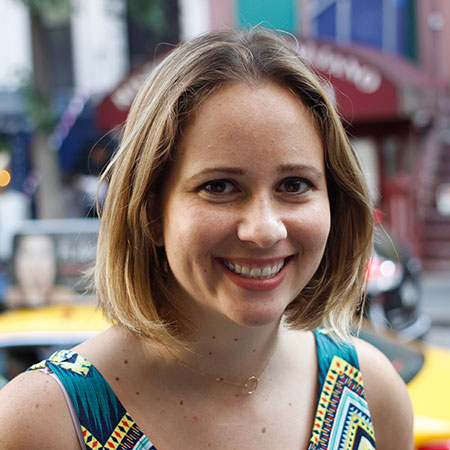A human-centric office sets an example in spite of strict energy requirements and a limited luminaire vocabulary
By Katie Nale
As though they were stripped from a Millennial’s fantasy apartment, the green walls of plants throughout Delos’s New York City headquarters send a dual message to all who enter: we care about health and we care about you. Of course, given the office’s tenant, the visual statement of wellness is hardly a surprise. Delos—the real estate and technology firm that developed the WELL Building Standard—wanted its new office to be an example project and a touchstone for those wanting to see a space meeting the requirements of LEED v4 Platinum, WELL Platinum and the Living Building Challenge.
“The goals were to make it as healthy and human-focused as it could be,” says the project’s principal lighting designer, Chad Groshart of Atelier Ten (New York City), who worked on the office between December 2015 and May 2017 in conjunction with Gensler (New York), the interior architect. A focus on visually comfortable illumination through daylighting, tunable fixtures and circadian lighting helped Groshart meet all industry codes and standards while emphasizing the building’s overall feeling of wellness.
Located on Manhattan’s West Side Highline, the two-floor 20,000-sq ft office has views of the Hudson River and an abundance of natural light. “The most important thing about creating healthy human-centric lighting is good access to daylight, and this project had that in spades,” recalls Groshart, who began the project by looking at the daylighting characteristics of the space. “I took it as a visual environment assignment to really understand the health and quality-of-life impact of daylight, all the way through to the electric lighting piece.”
Groshart started with an ambient layer of light created by track lighting in private areas and linear fixtures in private and open spaces. “We worked on tuning and setting lighting scenes that included a lot of human-centric options that run on a program throughout the day so that the space would help [employees] stay entrained by giving them a good dose of blue light, especially away from the windows.”
Groshart used both daylighting and electric lighting for the circadian calculations throughout the office, but ran into challenges finding fixtures to pair with the client’s selected electric sources. “Delos had a partner they really like called Ketra—this is before they were owned by Lutron,” recalls Groshart. “They made controls, as well as sources, but they didn’t make fixtures, which was really tricky.” Starting off with a PAR lamp and a linear source without housing, Groshart had to get creative about coming up with a vocabulary of fixtures that would result in the downlighting and ambient illumination the office required.
“In the end, Ketra designed a fixture for the project that was a standalone fixture, but the color, the adjustability of the Ketra sources, was really what Delos was looking for.” Atelier Ten worked closely with Ketra to create a high-CRI, tunable fixture that hit WELL’s glare requirements, which now hangs throughout the office’s main area. “Part of the WELL Building Standard is giving people control over their environment, making people feel empowered by knowing that they don’t have to be cold, or hot, or in the dark or over-lit,” Groshart explains. Ketra proprietary controls are used throughout the office, allowing each fixture to be individually controlled. Fixtures are grouped in reconfigurable zones that are controlled by wall stations.
Individual work spaces with tunable Mossa Pro desk lamps also further each employee’s ability to create a personalized work environment.
The space’s strict environmental requirements also presented challenges. Lighting power density and lumen output were the trickiest metrics to balance, as the tunable white technology requested by the owner had lower LED efficacies due to the very broad Kelvin range. “Tunable white systems often come at a higher wattage consumption, so we needed to carefully balance the footcandle levels required to meet the various WELL v1 criteria with the ambitious energy reduction goals set to achieve multiple points for LEED v4’s Optimize Energy Performance credit,” says Groshart. In addition to providing individual control, the range of color temperatures was also an important factor for Delos to achieve WELL v1’s Feature 54, Circadian Lighting Design, with use of tunable white technology. “The lamping we chose to use throughout (with the exception of a few accents) has a very wide tunable range from 1400K to 10,000K.”
A large number of Groshart’s clients from New York have found opportunities to visit the Delos office to spend time in a WELL Platinum, Living Building Challenge and LEED v4 Platinum space. Excited by the discussions the office sparks about sustainability, he notes that the space acts as a counter-weight to other projects developed in recent years in which the rush toward sustainability has eroded the quality of interior spaces. “I’m refreshed to see people valuing other metrics for their building, not just energy efficiency and cost per sq ft,” he says. “I think the most important take-away from this project is that there are people who are really looking for answers to make better environments for humans.”
One unexpected result of the design of the office, is the smell. “I hear over and over again, ‘It smells really good in here.’ People who aren’t lighting designers are not necessarily aware that
it is a combination of super high-color rendering, carefully-tuned max and great materials that combine to a make a subtle but powerful scent.”


